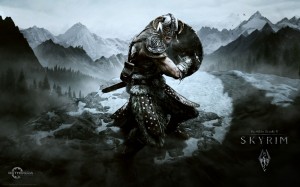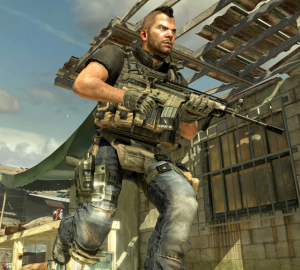
Back in 2011, I wrote on my own blog about storytelling in video games, and whether or not they are a narrative art form, a post that led me to wonder:
[D]o video games really want to be known as a narrative art form?
I find this question far more interesting than Ebert’s question about whether they’re art or not. (Simple answer: some are, some aren’t!)
Right now, video games are in a sweet spot. Games like Heavy Rain and Mass Effect 2 can come out and gain a certain amount of cachet and sales because of their sophisticated deployment of game mechanics to complexly explore genre. At the same time, when people question the racial politics of Resident Evil 5 or look at the truly execrable pro-torture narrative of Black Ops, gamers (and game critics) can retreat behind “Hey, it’s only a game!”
Sure enough, over the last couple of years, I’ve noticed more talk about the quality of stories that games tell and the phenomena of ludonarrative dissonance, or the disconnect between the gameplay experience and the narrative experience of a title. Most of these conversations tend to coalesce around fretting about violence. In the Uncharted games, rakish hero Nathan Drake kills something like six to eight hundred people whilst treasure hunting around the globe. The emotional resonance of Bioshock: Infinite’s clever universe-hopping maze of a plot is undermined by the constant need to mow down everyone who gets in your way. In fact, the term ludonarrative dissonance apparently originates with this blog post from Clint Hocking about the first Bioshock game, in which he writes that the contrast between the selfishness of the game play (it’s a first person shooter) and the anti-selfishness polemics of the plot (it’s a takedown of objectivism) contrast to such a degree that it wrecks the game.
I personally find the concept of ludonarrative dissonance interesting for thinking and discussing video games but do not find it to be quite the magic bullet that game critics seem to think it is. Basically, I believe that, in part due to the history of how games have aesthetically developed, game players are quite used to compartmentalizing gameplay from story, tending to either view the former as the task one must accomplish to get the latter, or viewing the latter as the increasingly cumbersome speed bumps that interrupt the former.
While the violent gameplay is the least interesting part of Bioshock:Infinite, I’m not sure that most video game players think that they’re killing people as they play it from a narrative perspective any more than watchers of Looney Tunes feel Elmer Fudd’s physical pain in any kind of serious way. Aesthetics matter, after all, and Bioshock:Infinite is a candy colored cartoon wonderland filled with nonrealistic character portraits. Most of the human extras you encounter throughout the world are more like animatronic dolls than people. It’s also worth noting that violence is in many ways woven into the DNA of videogames, much as snark and assumptions of bad faith are woven into the DNA of online discourse.
That said, ludonarrative dissonance will prove a worthwhile concept if it leads to better games and better narrative mechanics within them, and over the past year, at least, this appears to be happening. Two recent works, Telltale Games’ The Walking Dead and Naughty Dog’s The Last of Us have done a remarkable job of integrating gameplay mechanics, story, and theme, pointing the way to a possible new maturity in the field. Yet at the same time, both are built out of sturdy video game genres. The Walking Dead is a classic puzzle-adventure game, while The Last of Us focuses on the kind of stealth-action familiar to players of Metal Gear Solid, Deus Ex or the Tenchu franchise. They never lose their game-ness[1], yet remain satisfying, emotionally engaging, thought provoking narrative experiences[2].
The Walking Dead even manages to upstage both the preexisting source material (the comics by Robert Kirkman) and the blockbuster TV adaptation on AMC. In it, you play Lee Everett, a recently convicted murderer (and former college professor) being transported to prison when the cop car carrying you hits a zombie. Shortly thereafter, you take on a young girl named Clementine, whose parents are in another city and whose babysitter has gone all let-me-eat-your-brains on you[3]. As you and Clementine struggle to survive, you eventually come upon other survivors and have a series of difficult trials that brings you both across the state of Georgia.
On a gameplay level, much of The Walking Dead revolves around the normal puzzle-adventure michegas, where you have to figure out what action and items will get you from point A to point B in the plot. Occasionally, you also have to kill zombies or hostile humans. Neither of these functions are particularly remarkable. And at least one puzzle, which involves figuring out the right things to say to get someone to move out of your way so that you can press a button, is seriously infuriating. What makes the game work, however, is the way that character, emotion and choice function within the narrative. Like many games today, The Walking Dead presents the player with multiple narrative choices via either forcing you to take one of a series of mutually exclusive actions or choosing dialogue options in conversations.
Telltale’s stroke of genius was to insert a timer into these decisions. Normally when you reach a major choice in a game, it will wait for you. You can think about it for a while, perhaps peruse a walkthrough online that will tell you the outcome of the choices, and then make it. You can perform a cost-benefit analysis in other words, thinking about it purely in game terms. In The Walking Dead, you have a very limited time to make each decision, and as a result, the decisions become a reflection of your personality, or the personality of Lee as you’ve chosen to play him[4]. Perhaps you think Lee should tell people he’s a convicted murderer, because honesty is the best policy. Or perhaps you think you should hide it from people because you’re a good guy and you don’t want people pre-judging you. Perhaps you should tell people you’re Clementine’s father. Or her babysitter. Perhaps you raid that abandoned station wagon filled with food. Or perhaps you sit back, willing to go hungry in case the car belongs to fellow survivors.
Many of your choices involving brokering disagreements between two survivors named Kenny and Lily, who are both, to put it politely, assholes. Kenny, a redneck father, will do anything for the survival of his family (including betray you), and will forget any nice thing you do for him (including saving his life) the second you disagree with him. Lily, the defacto leader of the group, is belligerent, domineering, and frequently sticks up for her racist shitbag dad. Being a good middle child, I kept opting for choices that recognized the validity of their points of view and tried to form consensus. Due to their aforementioned assholitry, they both hated me by halfway through the game. One of them even told me I had to man up and start making decisions or what was the point of having me along.
The decisions tend to function like this in the game. Unlike in most games with choice mechanics, there aren’t morally good and bad choices coded blue and red. And unlike old school adventure games, the choices you make in the plot won’t lead to fail states. They simply are things that you’ve done, and they ripple out throughout the game, shifting (in ways both subtle and non) how the story progresses, how people treat you, and what choices you have remaining to you.
None of this exactly explains what a remarkable achievement The Walking Dead game turned out to be. So let me try some other ways: It’s the only game I’ve played that has reduced every person I know who has played it to tears at least twice. It’s the only game I’ve ever played where the characters are so clearly and humanly written that I finished one chapter of it and flew into a rage over what one of the characters did to me[5].
Part of this is because there are limits to what your choices can achieve. Due to the realities of game making and the limitations of the engine that’s running underneath TWD’s hood, the number of paths you can take in the game is finite. There are truncation points in the branching narrative to keep things under control. As a result, certain things will happen no matter what you do and certain characters will die. There are things you cannot stop from occurring in the game, fates that, like the protagonist in a play by Euripides, are inexorable and horrible all at once.
I wouldn’t have it any other way. Robert Kirkland’s two great innovations in the zombie apocalypse genre—telling a story with no finite ending and making zombieism inevitable[6]—are what gave early issues of the comic book their thematic sizzle, turning the saga into a story about how we confront our mortality and an ongoing essay into whether death made life more meaningful or a sick joke. Sadly, after a difficult and necessary foray into the issue of survivor’s guilt, the comics are largely now about how difficult and noble it is to be the White Man in Charge who makes the tough decisions and often feature Rick Grimes walking around having other people tell him how awesome he is while he gets ever more self-pitying.
The video game, meanwhile, does a superior job of exploring the themes of its source material, because the choice mechanics literalize those themes. By removing fail states from the game (like most contemporary video games, it is literally impossible to lose The Walking Dead) and eschewing simple morality in designing the choices, TWD constantly forces you to think about why you are making the choices you make. As you decide whether or not to save the female reporter and firearms expert or a male hacker dweeb you may find yourself suddenly thinking Oh crap, I have to choose between one of these people. And they both seem so nice. But, well, this is the apocalypse, so electronics aren’t going to be as necessary. And that reporter is a markswoman. And at some point the world is going to need to be repopulated, so I suppose I need to save as many potential sexual partners as possible. So I guess I’m going to save the reporter. [CLICK] Wait. Am I terrible person?
It’s rare that games provoke that kind of calculus. And it’s very rare that they are constructed in a way that forces you to think about not just the decisions you make but why you make them. By the end of the game, as a mysterious stranger interrogates you about every major decision you’ve made over the last ten or so hours of gameplay, it’s hard not to notice that what you’ve just been playing is a length examination not just of what it means to survive, but of yourself.
(This is part one of a two-part essay on recent advances in video game storytelling. Part two will run soon)
CORRECTION: I’ve been a little remiss in apportioning credit in the above. The idea of infectionless zombies dates back to Romero and, of course, The Walking Dead was co-created by artist Terry Moore and, after its first few issues, has been co-created by artist Charlie Adlard. Apologies to the relevant parties.
[1] Oddly, both games have been criticized for still being too “game-like.” This strikes me as wrongheaded, akin to arguing that a graphic novel, by including panels and images, wasn’t enough like a prose book. Or that book, by being made out of words, wasn’t enough like a television show. If we want the medium of games to improve, it shouldn’t be via them becoming very long movies.
[2] Please take the fact that I used as clunky a phrase as “narrative experiences” in this sentence as a sign of the newness of taking narrative in video games seriously and the difficulty in discussing same.
[3] You put a hammer through her head. But at least it’s justified by the world.
[4] This was even more true when the game was initially released in a serialized 5 episode format. A choice you make in Episode 2 might not pay off until Episode 5, thus making a walkthrough of your choices totally useless.
[5] Or should I say Lee? This gets me to a side point that I don’t have much time to get into here: The relationship between choice mechanics and attachment to games. There is something about having a say in the way a game progresses that creates in most gamers I know a greater sense of emotional attachment to the events as they unfold. I think on some level we come to care for our characters (and the characters around them) as if they were our charges. We don’t want bad things to happen to them, and have at least some ability to keep them out of trouble. When we fail, it’s heartbreaking. And I feel silly about owning up to the fact that it’s heartbreaking, because, after all, this is a fucking video game we are talking about here people. It’s probably—outside of hardcore pornography—the medium with the most uneven ratio of profit to respectability there is.
[6] In the world of The Walking Dead, all dead people become zombies. Zombie bites spread a poison that helps speed the process of death along. The only way to stop this process is to have whoever is with you—likely a loved one or friend—kill you by shooting you in the head or otherwise destroying your brain.



















